Discriminative Local Feature for Hyperspectral Hand Biometrics by Adjusting Image Acutance
Abstract
:Featured Application
Abstract
1. Introduction
2. Adjusting Image Acutance
2.1. Assessing Image Acutance
2.2. Modified Image Acutance
2.3. Determining an Optimal Range of Image Acutance
3. Experiments
3.1. Databases
3.2. Experimental Settings
3.3. Experimental Results
3.4. Experimental Analysis
3.5. Computation Time
4. Conclusions
Author Contributions
Funding
Acknowledgments
Conflicts of Interest
References
- Barra, S.; De Marsico, M.; Nappi, M.; Narducci, F.; Riccio, D. A hand-based biometric system in visible light for mobile environments. Inf. Sci. 2019, 479, 472–485. [Google Scholar] [CrossRef]
- Klonowski, M.; Plata, M.; Syga, P. User authorization based on hand geometry without special equipment. Pattern Recognit. 2018, 73, 189–201. [Google Scholar] [CrossRef]
- Guo, J.M.; Hsia, C.H.; Liu, Y.F.; Yu, J.C.; Chu, M.H.; Le, T.N. Contact-free hand geometry-based identification system. Expert Syst. Appl. 2012, 39, 11728–11736. [Google Scholar] [CrossRef]
- Gupta, P.; Srivastava, S.; Gupta, P. An accurate infrared hand geometry and vein pattern based authentication system. Knowl.-Based Syst. 2016, 103, 143–155. [Google Scholar] [CrossRef]
- Zhong, D.X.; Shao, H.K.; Du, X.F. A Hand-Based Multi-Biometrics via Deep Hashing Network and Biometric Graph Matching. IEEE Trans. Inf. Forensics Secur. 2019, 14, 3140–3150. [Google Scholar] [CrossRef]
- Fei, L.K.; Zhang, B.; Xu, Y.; Guo, Z.H.; Wen, J.; Jia, W. Learning Discriminant Direction Binary Palmprint Descriptor. IEEE Trans. Image Process. 2019, 28, 3808–3820. [Google Scholar] [CrossRef]
- Zhong, D.X.; Du, X.F.; Zhong, K.C. Decade progress of palmprint recognition: A brief survey. Neurocomputing 2019, 328, 16–28. [Google Scholar] [CrossRef]
- Jia, W.; Zhang, B.; Lu, J.T.; Zhu, Y.H.; Zhao, Y.; Zuo, W.M.; Ling, H.B. Palmprint Recognition Based on Complete Direction Representation. IEEE Trans. Image Process. 2017, 26, 4483–4498. [Google Scholar] [CrossRef]
- Fei, L.K.; Lu, G.M.; Jia, W.; Teng, S.H.; Zhang, D. Feature Extraction Methods for Palmprint Recognition: A Survey and Evaluation. IEEE Trans. Syst. Man Cybern. Syst. 2019, 49, 346–363. [Google Scholar] [CrossRef]
- Zhong, D.X.; Shao, H.K.; Liu, S.M. Towards application of dorsal hand vein recognition under uncontrolled environment based on biometric graph matching. IET Biom. 2019, 8, 159–167. [Google Scholar] [CrossRef]
- Wang, Y.D.; Xie, W.; Yu, X.J.; Shark, L.K. An Automatic Physical Access Control System Based on Hand Vein Biometric Identification. IEEE Trans. Consum. Electron. 2015, 61, 320–327. [Google Scholar] [CrossRef]
- Huang, D.; Zhang, R.K.; Yin, Y.A.; Wang, Y.D.; Wang, Y.H. Local feature approach to dorsal hand vein recognition by Centroid-based Circular Key-point Grid and fine-grained matching. Image Vis. Comput. 2017, 58, 266–277. [Google Scholar] [CrossRef]
- Wu, W.; Elliott, S.J.; Lin, S.; Yuan, W.Q. Low-cost biometric recognition system based on NIR palm vein image. IET Biom. 2019, 8, 206–214. [Google Scholar] [CrossRef]
- Yan, X.K.; Kang, W.X.; Deng, F.Q.; Wu, Q.X. Palm vein recognition based on multi-sampling and feature-level fusion. Neurocomputing 2015, 151, 798–807. [Google Scholar] [CrossRef]
- Ma, S.; Tao, Z.; Yang, X.F.; Yu, Y.; Zhou, X.; Li, Z.W. Bathymetry Retrieval from Hyperspectral Remote Sensing Data in Optical-Shallow Water. IEEE Trans. Geosci. Remote Sens. 2014, 52, 1205–1212. [Google Scholar] [CrossRef]
- Wang, W.X.; Fu, Y.T.; Dong, F.; Li, F. Semantic segmentation of remote sensing ship image via a convolutional neural networks model. IET Image Process. 2019, 13, 1016–1022. [Google Scholar] [CrossRef]
- Lakhal, M.I.; Cevikalp, H.; Escalera, S.; Ofli, F. Recurrent neural networks for remote sensing image classification. IET Comput. Vis. 2018, 12, 1040–1045. [Google Scholar] [CrossRef] [Green Version]
- Chen, G.Y.; Li, C.J.; Sun, W. Hyperspectral face recognition via feature extraction and CRC-based classifier. IET Image Process. 2017, 11, 266–272. [Google Scholar] [CrossRef]
- Ferrer, M.A.; Morales, A.; Diaz, A. An approach to SWIR hyperspectral hand biometrics. Inf. Sci. 2014, 268, 3–19. [Google Scholar] [CrossRef]
- Pan, Z.H.; Healey, G.; Prasad, M.; Tromberg, B. Face recognition in hyperspectral images. IEEE Trans. Pattern Anal. Mach. Intell. 2003, 25, 1552–1560. [Google Scholar]
- Wang, L.; Leedham, G. Near- and Far-Infrared Imaging for Vein Pattern Biometrics. In Proceedings of the 2006 IEEE International Conference on Video and Signal Based Surveillance, Sydney, Australia, 22–24 November 2006; p. 52. [Google Scholar]
- Fei, L.K.; Zhang, B.; Zhang, W.; Teng, S.H. Local apparent and latent direction extraction for palmprint recognition. Inf. Sci. 2019, 473, 59–72. [Google Scholar] [CrossRef]
- Zhang, D.; Zhenhua, G.; Guangming, L.; Lei, Z.; Wangmeng, Z. An Online System of Multispectral Palmprint Verification. IEEE Trans. Instrum. Meas. 2010, 59, 480–490. [Google Scholar] [CrossRef]
- Hong, D.; Liu, W.; Su, J.; Pan, Z.; Wang, G. A novel hierarchical approach for multispectral palmprint recognition. Neurocomputing 2015, 151, 511–521. [Google Scholar] [CrossRef]
- Guo, Z.; Zhang, D.; Zhang, L.; Liu, W. Feature Band Selection for Online Multispectral Palmprint Recognition. IEEE Trans. Inf. Forensics Secur. 2012, 7, 1094–1099. [Google Scholar] [CrossRef]
- Rice, A. A Quality Approach to Biometric Imaging. Available online: https://ieeexplore.ieee.org/document/307921 (accessed on 6 October 2019).
- Huang, D.; Zhu, X.R.; Wang, Y.H.; Zhang, D. Dorsal hand vein recognition via hierarchical combination of texture and shape clues. Neurocomputing 2016, 214, 815–828. [Google Scholar] [CrossRef]
- Wang, J.; Wang, G.; Zhou, M. Bimodal Vein Data Mining via Cross-Selected-Domain Knowledge Transfer. IEEE Trans. Inf. Forensics Secur. 2018, 13, 733–744. [Google Scholar] [CrossRef]
- Chuang, S.-J. Vein recognition based on minutiae features in the dorsal venous network of the hand. Signal Image Video Process. 2017, 12, 573–581. [Google Scholar] [CrossRef]
- Chen, K.; Zhang, D. Band Selection for Improvement of Dorsal Hand Recognition. In Proceedings of the 2011 International Conference on Hand-Based Biometrics, Hong Kong, China, 17–18 November 2011; pp. 1–4. [Google Scholar]
- Chen, X.; Zhou, Z.H.; Zhang, J.S.; Liu, Z.L.; Huang, Q.S. Local convex-and-concave pattern: An effective texture descriptor. Inf. Sci. 2016, 363, 120–139. [Google Scholar] [CrossRef]
- Liu, L.; Chen, J.; Fieguth, P.; Zhao, G.Y.; Chellappa, R.; Pietikainen, M. From BoW to CNN: Two Decades of Texture Representation for Texture Classification. Int. J. Comput. Vis. 2019, 127, 74–109. [Google Scholar] [CrossRef]
- Wu, X.Q.; Zhang, D.; Wang, K.Q. Palm line extraction and matching for personal authentication. IEEE Trans. Syst. Man Cybern. Part A Syst. Hum. 2006, 36, 978–987. [Google Scholar] [CrossRef]
- Zhang, D.; Kong, W.K.; You, J.; Wong, M. Online palmprint identification. IEEE Trans. Pattern Anal. Mach. Intell. 2003, 25, 1041–1050. [Google Scholar] [CrossRef] [Green Version]
- Xu, Y.; Fei, L.K.; Wen, J.; Zhang, D. Discriminative and Robust Competitive Code for Palmprint Recognition. IEEE Trans. Syst. Man Cybern. Syst. 2018, 48, 232–241. [Google Scholar] [CrossRef]
- Wang, Y.D.; Zhang, K.; Shark, L.K. Personal identification based on multiple keypoint sets of dorsal hand vein images. IET Biom. 2014, 3, 234–245. [Google Scholar] [CrossRef]
- Lee, J.C.; Lo, T.M.; Chang, C.P. Dorsal hand vein recognition based on directional filter bank. Signal Image Video Process. 2016, 10, 145–152. [Google Scholar] [CrossRef]
- Yao, Z.G.; Le Bars, J.M.; Charrier, C.; Rosenberger, C. Literature review of fingerprint quality assessment and its evaluation. IET Biom. 2016, 5, 243–251. [Google Scholar] [CrossRef]
- Abhyankar, A.; Schuckers, S. Iris quality assessment and bi-orthogonal wavelet based encoding for recognition. Pattern Recognit. 2009, 42, 1878–1894. [Google Scholar] [CrossRef]
- Abaza, A.; Harrison, M.A.; Bourlai, T.; Ross, A. Design and evaluation of photometric image quality measures for effective face recognition. IET Biom. 2014, 3, 314–324. [Google Scholar] [CrossRef] [Green Version]
- Wang, J.; Wang, G.Q. Quality-Specific Hand Vein Recognition System. IEEE Trans. Inf. Forensics Secur. 2017, 12, 2599–2610. [Google Scholar] [CrossRef]
- Zhang, K.N.; Huang, D.; Zhang, B.; Zhang, D. Improving texture analysis performance in biometrics by adjusting image sharpness. Pattern Recognit. 2017, 66, 16–25. [Google Scholar] [CrossRef]
- Krotkov, E. Focusing. Int. J. Comput. Vis. 1988, 1, 223–237. [Google Scholar] [CrossRef]
- Wang, H.-N.; Zhong, W.; WANG, J.; XIA, D. Research of measurement for digital image definition. J. Image Graph. 2004, 9, 828–831. [Google Scholar]
- Jain, A.K.; Duin, R.P.W.; Mao, J.C. Statistical pattern recognition: A review. IEEE Trans. Pattern Anal. Mach. Intell. 2000, 22, 4–37. [Google Scholar] [CrossRef]
- Russakovsky, O.; Deng, J.; Su, H.; Krause, J.; Satheesh, S.; Ma, S.; Huang, Z.H.; Karpathy, A.; Khosla, A.; Bernstein, M.; et al. ImageNet Large Scale Visual Recognition Challenge. Int. J. Comput. Vis. 2015, 115, 211–252. [Google Scholar] [CrossRef] [Green Version]
- Li, X.X.; Huang, D.; Wang, Y.H. Comparative Study of Deep Learning Methods on Dorsal Hand Vein Recognition. In Proceedings of the Chinese Conference on Biometric Recognition, Chengdu, China, 14–16 October 2016; pp. 296–306. [Google Scholar]
- Bishop, C.M. Pattern Recognition and Machine Learning; Springer: New York, NY, USA, 2006; pp. 186–189. [Google Scholar]


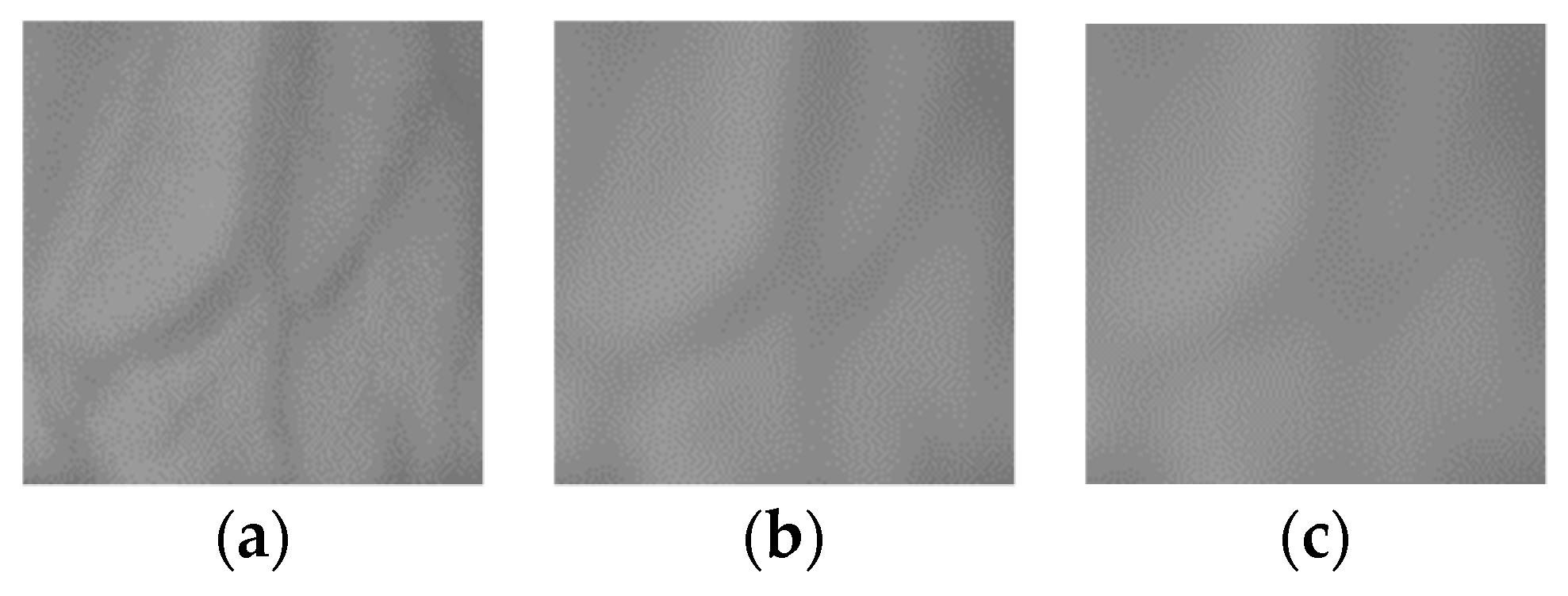
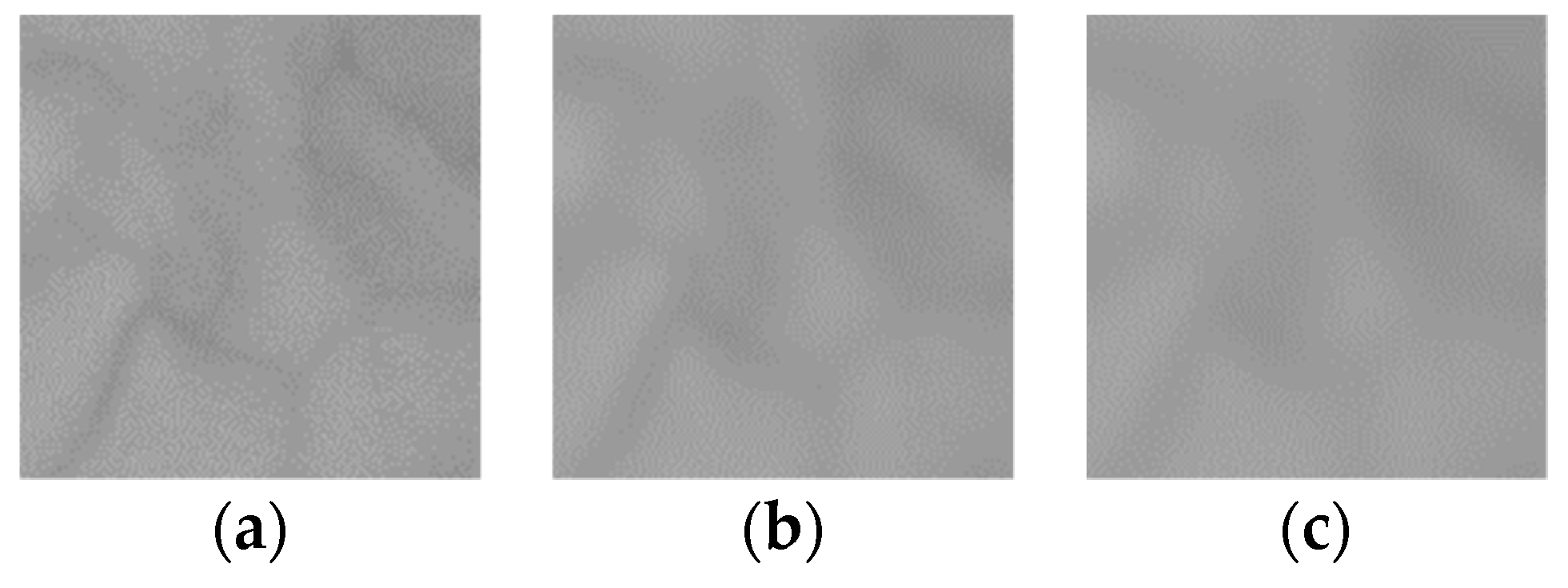
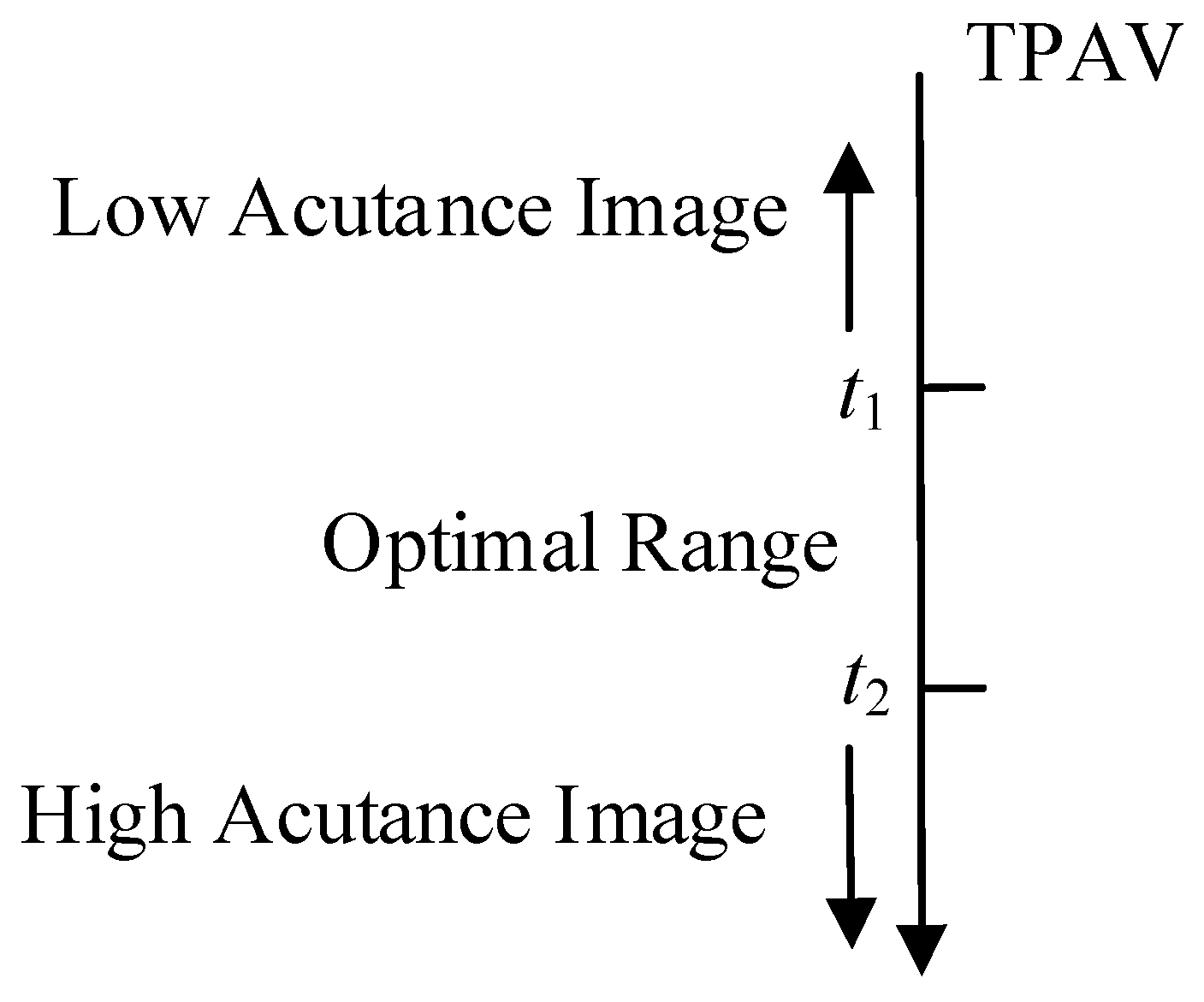





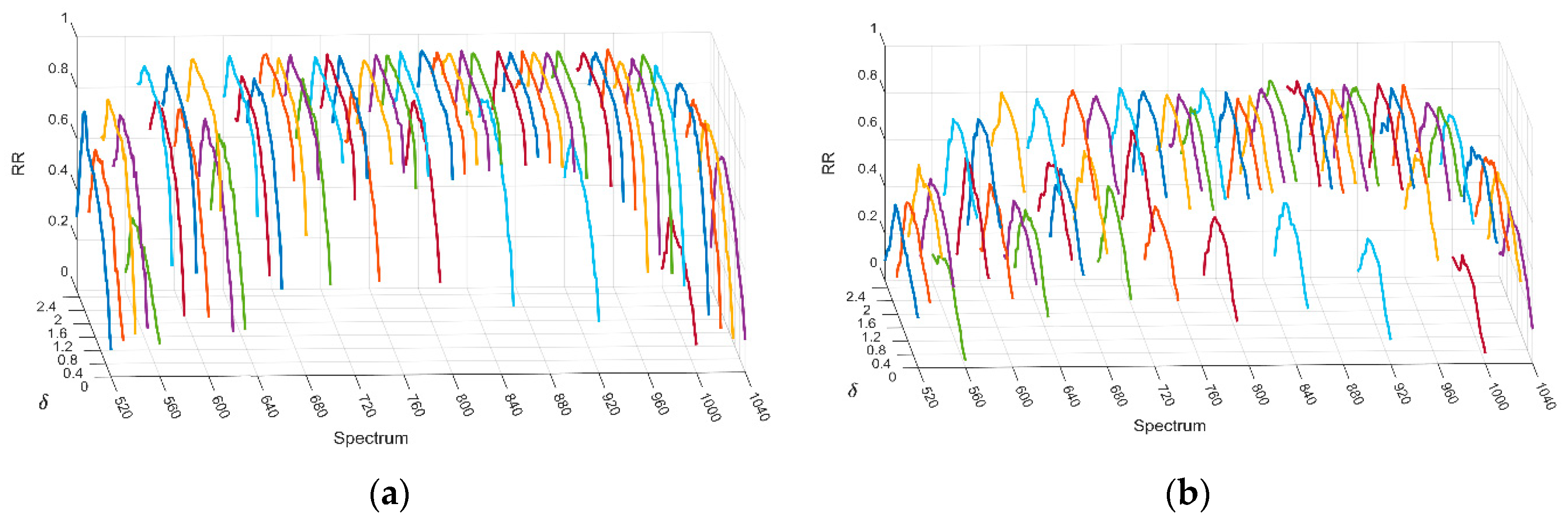



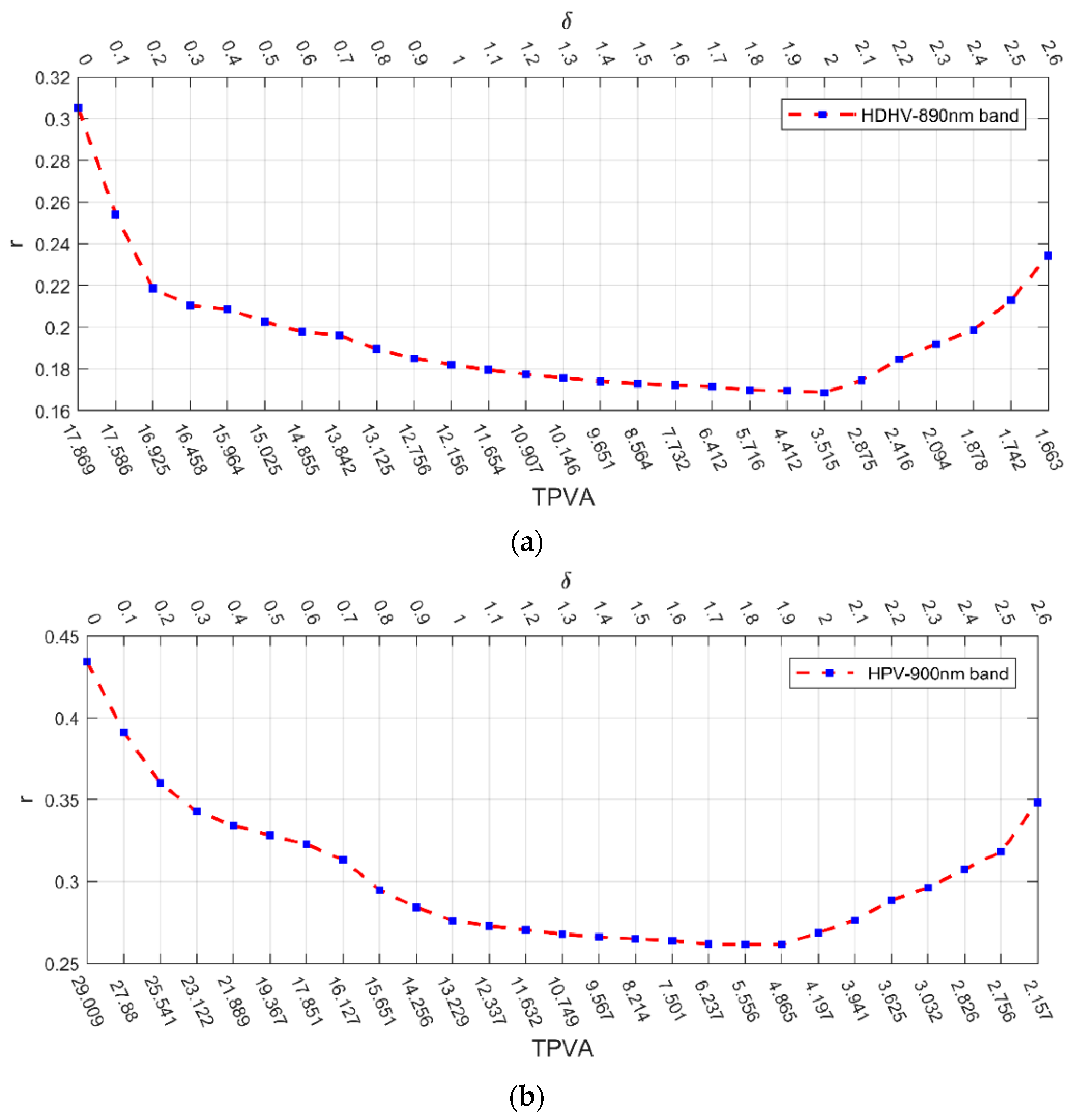
| Dataset | Local Pattern | Band | RR 1 (In Optimal Range) | RR (Original Image) | Improvement | |
|---|---|---|---|---|---|---|
| HDHV | Reginal LBP | 890 nm | 3.515–6.412 | 0.9833 | 0.9583 | 2.6% |
| All | - | 0.9540 | 0.7365 | 29.5% | ||
| Deep feature | 890 nm | 3.515–6.412 | 0.9750 | 0.9542 | 2.2% | |
| All | - | 0.8426 | 0.6154 | 36.9% | ||
| HPV | CompCode | 900 nm | 4.865–6.237 | 0.9928 | 0.7919 | 25.3% |
| All | - | 0.8964 | 0.6152 | 45.7% | ||
| Deep feature | 900 nm | 4.865–6.237 | 0.9809 | 0.7895 | 24.2% | |
| All | - | 0.7317 | 0.4414 | 65.7% |
| Spectrum | (Original Image) | ||
|---|---|---|---|
| 890 nm (HDHV) | 3.515–6.412 | 0.1686 | 0.3052 |
| 900 nm (HPV) | 4.865–6.237 | 0.2615 | 0.4344 |
| Database | Acutance Adjusting | Feature Extraction | Featuring Matching | Total Time |
|---|---|---|---|---|
| HDHV | 0.0241 | 0.0153 1 | 0.0108 | 0.0502 |
| HPV | 0.0225 | 0.0356 2 | 0.0135 | 0.0716 |
| MPP | 0.0221 | 0.0345 2 | 0.0166 | 0.0732 |
© 2019 by the authors. Licensee MDPI, Basel, Switzerland. This article is an open access article distributed under the terms and conditions of the Creative Commons Attribution (CC BY) license (http://creativecommons.org/licenses/by/4.0/).
Share and Cite
Nie, W.; Zhang, B.; Zhao, S. Discriminative Local Feature for Hyperspectral Hand Biometrics by Adjusting Image Acutance. Appl. Sci. 2019, 9, 4178. https://doi.org/10.3390/app9194178
Nie W, Zhang B, Zhao S. Discriminative Local Feature for Hyperspectral Hand Biometrics by Adjusting Image Acutance. Applied Sciences. 2019; 9(19):4178. https://doi.org/10.3390/app9194178
Chicago/Turabian StyleNie, Wei, Bob Zhang, and Shuping Zhao. 2019. "Discriminative Local Feature for Hyperspectral Hand Biometrics by Adjusting Image Acutance" Applied Sciences 9, no. 19: 4178. https://doi.org/10.3390/app9194178
APA StyleNie, W., Zhang, B., & Zhao, S. (2019). Discriminative Local Feature for Hyperspectral Hand Biometrics by Adjusting Image Acutance. Applied Sciences, 9(19), 4178. https://doi.org/10.3390/app9194178







